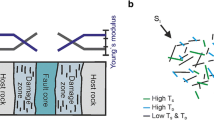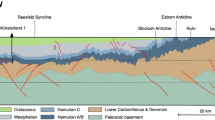Abstract
High geostress will become a normality in the deep because in-situ stress rises linearly with depth. The geological structure grows immensely intricate as depth increases. Faults, small fractures, and joint fissures are widely developed. The objective of this paper is to identify geostress anomalies at a variety of locations near faults and to demonstrate their accumulation mechanism. Hydrofracturing tests were conducted in seven deep boreholes. We conducted a test at a drilling depth of over one thousand meters to reveal and quantify the influence of faults on in-situ stresses at the hanging wall, footwall, between faults, end of faults, junction of faults, and far-field of faults. The effect of fault sites and characteristics on the direction and magnitude of stresses has been investigated and compared to test boreholes. The accumulation heterogeneity of stresses near faults was illustrated by a three-dimensional numerical simulation, which is utilized to explain the effect of faults on the accumulation and differentiation of in-situ stress. Due to regional tectonics and faulting, the magnitude, direction, and stress regime are all extremely different. The concentration degree of geostress and direction change will vary with the location of faults near faults, but the magnitude and direction of in-situ stress conform to regional tectonic stress at a distance from the faults. The focal mechanism solution has been verified using historical seismic ground motion vectors. The results demonstrate that the degree of stress differentiation varies according to the fault attribute and its position. Changes in stress differentiation and its ratio from strong to weak occur between faults, intersection, footwall, end of faults, and hanging wall; along with the sequence of orientation is the footwall, between faults, the end of faults, intersection, and hanging wall. This work sheds new light on the fault-induced stress accumulation and orientation shift mechanisms across the entire cycle.
Similar content being viewed by others
References
M.C. He, Rock mechanics and hazard control in deep mining engineering in China, [in] Proceedings of the ISRM International Symposium 2006 and the 4th Asian Rock Mechanics Symposium, Singapore, 2006.
P. Xu, R.S. Yang, J.J. Zuo, et al., Research progress of the fundamental theory and technology of rock blasting, Int. J. Miner. Metall. Mater., 29(2022), No. 4, p. 705.
P. Li, M.F. Cai, Q.F. Guo, and S.J. Miao, Characteristics and implications of stress state in a gold mine in Ludong area, China, Int. J. Miner. Metall. Mater., 25(2018), No. 12, p. 1363.
J. Haddad, J. Ramos, and M. Aldana, In-situ stress constrain: A geomechanics study to evaluate the influence of the structural geology, [in] SPE Latin America and Caribbean Petroleum Engineering Conference, Maracaibo, 2014.
Z.Y. Tan and M.F. Cai, Measurement and study of the distributing law of in situ stresses in rock mass at great depth, J. Univ. Sci. Technol. Bei**g Miner. Metall. Mater., 13(2006), No. 3, p. 207.
T. Tokiwa, K. Tsusaka, E. Ishii, et al., Influence of a fault system on rock mass response to shaft excavation in soft sedimentary rock, Horonobe area, northern Japan, Int. J. Rock Mech. Min. Sci., 48(2011), No. 5, p. 773.
D.P. Yale, Fault and stress magnitude controls on variations in the orientation of in situ stress, [in] M. Ameen, ed., Fracture and In-Situ Stress Characterization of Hydrocarbon Reservoirs, Geological Society, London, 2003, p. 55.
P.A.J. van den Bogert and R.M.H.E. van Eijs, Why Mohr-circle analyses may underestimate the risk of fault reactivation in depleting reservoirs, Int. J. Rock Mech. Min. Sci., 136(2020), art. No. 104502.
Q. Jiang, G.S. Su, X.T. Feng, G.Q. Chen, M.Z. Zhang, and C. Liu, Excavation optimization and stability analysis for large underground caverns under high geostress: A case study of the Chinese Laxiwa Project, Rock Mech. Rock Eng., 52(2019), No. 3, p. 895.
X.H. Qin, Q.C. Chen, M.L. Wu, C.X. Tan, C.J. Feng, and W. Meng, In-situ stress measurements along the Beichuan-Yingxiu fault after the Wenchuan earthquake, Eng. Geol., 194(2015), p. 114.
Z.B. Guo, Y.L. Jiang, J.W. Pang, and J.W. Liu, Distribution of ground stress on Puhe Coal Mine, Int. J. Min. Sci. Technol., 23(2013), No. 1, p. 139.
Z.Q. Sun and J.H. Zhang, Variation of in-situ stresses before and after occurrence of geologic fault structure, Chin. J. Rock Mech. Eng., 23(2004), No. 23, p. 3964.
C.D. Chang, J.B. Lee, and T.S. Kang, Interaction between regional stress state and faults: Complementary analysis of borehole in situ stress and earthquake focal mechanism in southeastern Korea, Tectonophysics, 485(2010), No. 1–4, p. 164.
J.P. Liu, Z.S. Liu, S.Q. Wang, C.Y. Shi, and Y.H. Li, Analysis of microseismic activity in rock mass controlled by fault in deep metal mine, Int. J. Min. Sci. Technol., 26(2016), No. 2, p. 235.
C.Q. Zhang, X.T. Feng, and H. Zhou, Estimation of in situ stress along deep tunnels buried in complex geological conditions, Int. J. Rock Mech. Min. Sci., 52(2012), p. 139.
J. Rutqvist, B. Graupner, Y. Guglielmi, et al., An international model comparison study of controlled fault activation experiments in argillaceous claystone at the Mont Terri Laboratory, Int. J. Rock Mech. Min. Sci., 136(2020), art. No. 104505.
Y. Ju, C.B. Wan, Z.Y. Ren, L.T. Mao, G.M. Fu, and F.P. Chiang, Quantification of continuous evolution of full-field stress associated with shear deformation of faults using three-dimensional printing and phase-shifting methods, Int. J. Rock Mech. Min. Sci., 126(2020), art. No. 104187.
L.R. Alejano, U. Castro-Filgueira, A.M. Ferrero, M. Migliazza, and F. Vagnon, In situ stress measurement near fault and interpretation by means of discrete element modelling, Acta Geodyn. Geomater., 14(2017), No. 2, p. 181.
R. Chatterjee, Effect of normal faulting on in-situ stress: A case study from Mandapeta Field, Krishna-Godavari basin, India, Earth Planet. Sci. Lett., 269(2008), No. 3–4, p. 458.
P. Jeanne, J. Rutqvist, H.M. Wainwright, et al., Effects of in situ stress measurement uncertainties on assessment of predicted seismic activity and risk associated with a hypothetical industrial-scale geologic CO2 sequestration operation, J. Rock Mech. Geotech. Eng., 8(2016), No. 6, p. 873.
K. Matsuki, S. Nakama, and T. Sato, Estimation of regional stress by FEM for a heterogeneous rock mass with a large fault, Int. J. Rock Mech. Min. Sci., 46(2009), No. 1, p. 31.
S. Yin, R.C. **e, Z.H. Wu, J. Liu, and W.L. Ding, In situ stress heterogeneity in a highly developed strike-slip fault zone and its effect on the distribution of tight gases: A 3D finite element simulation study, Mar. Pet. Geol., 99(2019), p. 75.
B.T. Shen, Y. Duan, X. Luo, et al., Monitoring and modelling stress state near major geological structures in an underground coal mine for coal burst assessment, Int. J. Rock Mech. Min. Sci., 129(2020), art. No. 104294.
C.H. Wang, C.K. Song, Q.L. Guo, J.Z. Mao, and Y.S. Zhang, New insights into stress changes before and after the Wenchuan Earthquake using hydraulic fracturing measurements, Eng. Geol., 194(2015), p. 98.
P. Zhang, Z.P. Meng, S. Jiang, and X.M. Chen, Characteristics of in-situ stress distribution in Zhengzhuang Region, Southern Qinshui Basin, China and its stress path during depletion, Eng. Geol., 264(2020), art. No. 105413.
S.X. Deng, J. Li, H.M. Jiang, and M.Y. Wang, Experimental and theoretical study of the fault slip events of rock masses around underground tunnels induced by external disturbances, Eng. Geol., 233(2018), p. 191.
E. Paltrinieri, F. Sandrone, and J. Zhao, Analysis and estimation of gripper TBM performances in highly fractured and faulted rocks, Tunn. Undergr. Space Technol., 52(2016), p. 44.
A. Sainoki and H.S. Mitri, Dynamic behaviour of mining-induced fault slip, Int. J. Rock Mech. Min. Sci., 66(2014), p. 19.
Acknowledgements
This work was financially supported by the National Natural Science Foundation of China (Nos. 51574015 and 51934001) and the National Key Science and Technology Programs, China (No. 2018YFC0808004).
Author information
Authors and Affiliations
Corresponding author
Additional information
Conflict of Interest
The authors confirm that there are no known conflicts of interest associated with this publication and there has been no significant financial support for this work that could have influenced its outcome.
Rights and permissions
About this article
Cite this article
Tan, N., Yang, R. & Tan, Z. Influence of complicated faults on the differentiation and accumulation of in-situ stress in deep rock mass. Int J Miner Metall Mater 30, 791–801 (2023). https://doi.org/10.1007/s12613-022-2528-y
Received:
Revised:
Accepted:
Published:
Issue Date:
DOI: https://doi.org/10.1007/s12613-022-2528-y




